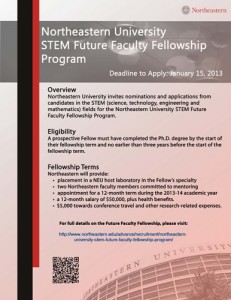We are pleased to inform you that the application is now open for the Department of Energy Computational Science Graduate Fellowship (DOE CSGF) at https://www.krellinst.org/doecsgf/application/. This is an exciting opportunity for doctoral students to earn up to four years of financial support along with outstanding benefits and opportunities while pursuing degrees in fields of study that utilize high performance computing technology to solve complex problems in science and engineering.
Benefits of the Fellowship:
- $36,000 yearly stipend
- Payment of all tuition and fees
- $5,000 academic allowance in first year
- $1,000 academic allowance each renewed year
- 12-week research practicum at a DOE Laboratory
- Yearly conferences
- Career, professional and leadership development
- Renewable up to four years
Applications for the next class of fellows are due on January 8, 2013. See the poster for additional information: http://www.krellinst.org/csgf/sites/default/files/CSGF%20Recruitment%20Poster%202013-14.pdf
The DOE CSGF is open to U.S. citizens or permanent resident aliens who are planning full-time, uninterrupted study toward a PhD at an accredited US university. Senior undergraduate and first-year doctoral students (at the time of application) in engineering and in the physical, computer, mathematical or life sciences are eligible to apply.
For more information regarding the fellowship and to access the online application, visit http://www.krellinst.org/csgf

